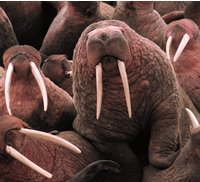
(Photo pf Pacific walrus at Cape Peirce, courtesy of U.S. Fish and Wildlife Service)
In a strange solution to a strange problem, federal wildlife biologists have built a 250-foot-long fence to stop walruses from plummeting off cliffs to their death on a Bristol Bay Beach in Alaska. About 30 bulls took the fatal plunge last year at Cape Peirce on Alaska's southwest coast, where thousands of the massive creatures gather to rest between meals.
According to the AP: If too many squeeze onto Maggy Beach, a quarter-mile-long strip of dark-brown sand, dozens may traipse up a chute and onto a grassy plateau. When it’s time to feed, the animals seem to beeline for the water, which leads them across the plateau and over a cliff that’s up to 150 feet above shore. Sand dunes used to block the chute. But over time, the3,000-pound walruses wore away the dunes, with help from the wind, and made their way up the chute.
Last week the biologists planted a $2,500, 3-foot-tall, wooden-slatted fence across the chute, biologist Rob MacDonald said. But it won’t be the barricade. It should work like a snow fence, creating sand dunes that pile up to16 feet high. That should keep the walruses from straying up to the plateau.
More than 12,000 walrus gathered at Cape Peirce annually in the1980s, said federal wildlife biologist Joel Garlich-Miller, making it the largest concentration of Pacific walruses in North America at the time. But the visiting herds dropped sharply for several years, with sometimes only dozens of animals showing up, he said.
Biologists aren’t worried the deaths will make a significant dent in the walrus population. The last estimate, in 1990, was 200,000, and a new count is under way.
No comments:
Post a Comment